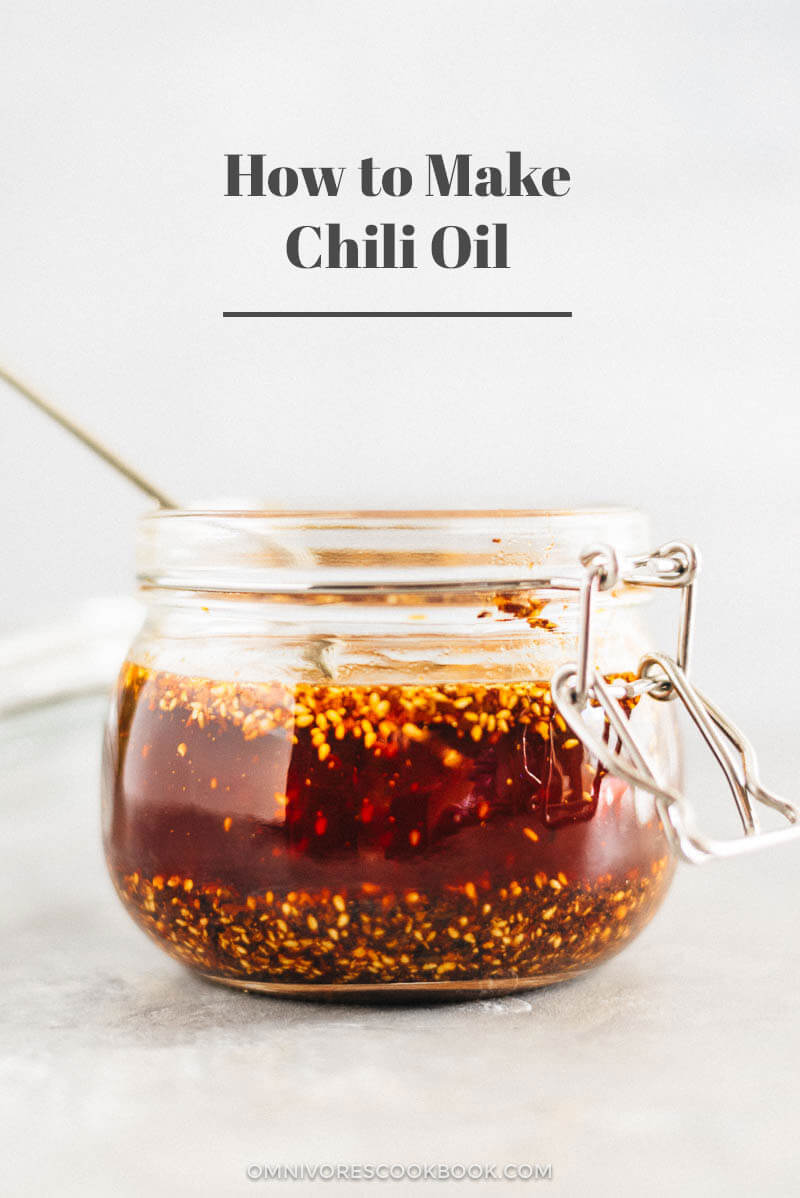
Chili oil is such an important staple for Chinese families, equal to soy sauce and vinegar. For many Chinese people chili oil is as important as ketchup is to American people. It always shows up on tables of small diners, no matter whether it’s a dumplings or noodle place. Once you’re hooked, you’ll want to pour it on everything.
Whenever I’m talking about chili oil, I always refer to homemade chili oil. It tastes ten times better than the store bought product, lasts just as long if you store it in the fridge, and does not contain additives or MSG. There is this fresh aromatic nuttiness that bottled chili oil never delivers.
Plus, when you use chili oil like a Chinese person, you gotta mix in the chili flakes as well. The chili flakes are well toasted when you cook the chili oil, so they taste less spicy but quite smoky with a crispy texture. When mixing with noodles, these tiny umami bits coat the ingredients evenly and each bite releases waves of piquant zing to your taste buds. It’s as exciting as throwing a handful of Pop Rocks in your mouth!
When I cook Vegetable Chow Mein, Lanzhou Beef Noodle soup, and hearty Sesame Noodle Salad, I’ll always spoon a few dollops of chili oil mixed with thick chili flakes onto my finished dish. This one small action will elevate your cooking from mundane to heavenly.
Cooking process
The process might look intimidating at first, but you won’t believe how easy it is once you try it. There are three steps involved.
(1) Combine chili flakes with aromatics of your choice in a heatproof bowl.
A ceramic bowl is my go-to choice. If you plan to use a glass jar, make sure it is heatproof. We will be dealing with hot oil in the next step. Using glassware might cause the glass to shatter and can be very dangerous.
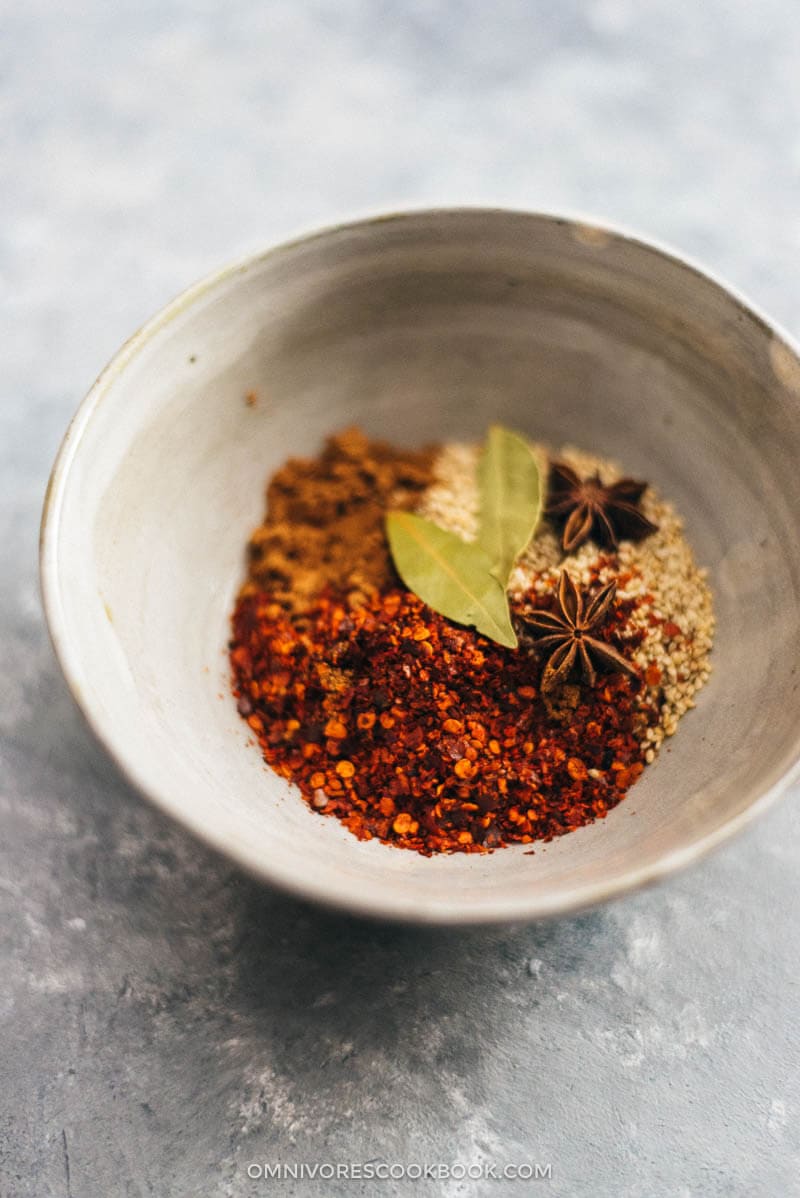
(2) Heat the oil until it reaches 370 degrees F (190 C).
The key to making delicious chili oil is to heat the oil hot enough without overheating it. The hot oil will cook the spices thoroughly and be infused with various flavors. However, if the oil is too hot, it will burn the pepper flakes and sesame seeds, and the resulting chili oil will be bitter in taste.
The best way is to use an instant thermometer to monitor the oil. If you do not have a thermometer, I also introduce a “ginger method” in the recipe below, which is a good indicator of the oil temperature.
Select a small saucepan that has long handle and is good for pouring. Alternatively, you can also use a ladle to transfer the oil.
(3) Pour oil into the bowl with chili flakes.
The oil will bubble fiercely at first and quickly cook the chili flakes. Simply mix everything together with a spoon and let the oil sit until cooled down.
That’s it! Now you have a jar of delicious chili oil to use to create an authentic Chinese flavor.
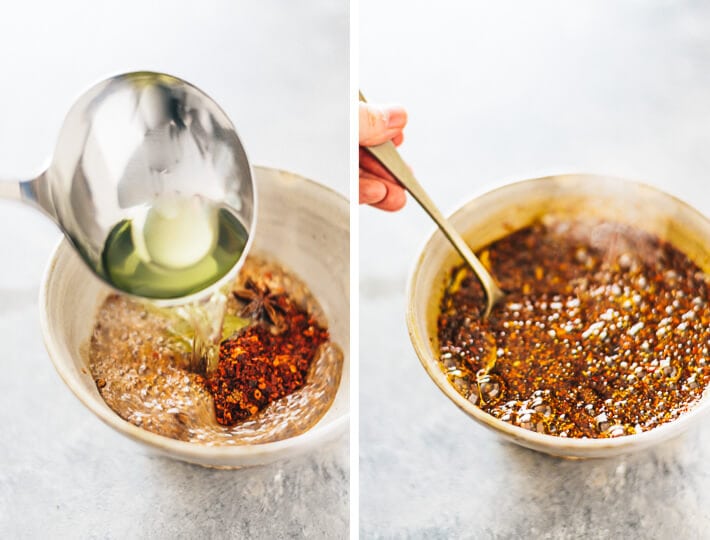
More cooking notes
(1) What types of chili flakes should you use?
The best option is to use fresh chili flakes imported from Sichuan. This type of chili flake is made with premium chili peppers of a vibrant red color. The blend also contains fewer seeds, so your chili oil won’t end up overly spicy.
The next best option is using Korean chili flakes. With these, I found my chili oil doesn’t have the brightest red color, but it doesn’t affect the taste.
(2) How do you make chili flakes?
You can use whole dried chili peppers to make chili flakes too. Lightly toast the peppers in a pan until the pepper turns a bit darker, and grind the peppers into chili flakes. To make sure the oil won’t turn out too spicy, cut open half of the hot peppers with kitchen shears and discard the seeds.
(3) What types of aromatics should you use in the chili oil?
The answer is, you can use many types of aromatics or none at all. The flavor is totally up to personal preference. In China, each region down to each family has their own formula to make their favorite chili oil.
To make the most basic chili oil, you can simply use chili flakes. Some versions use ginger, cinnamon bark, bay leaves, star anise etc.
The recipe below is our family’s formula. We always enjoy adding a few Sichuan peppercorns to add a hint of numbing nuttiness. We also use a pinch of five spice powder to add umami.
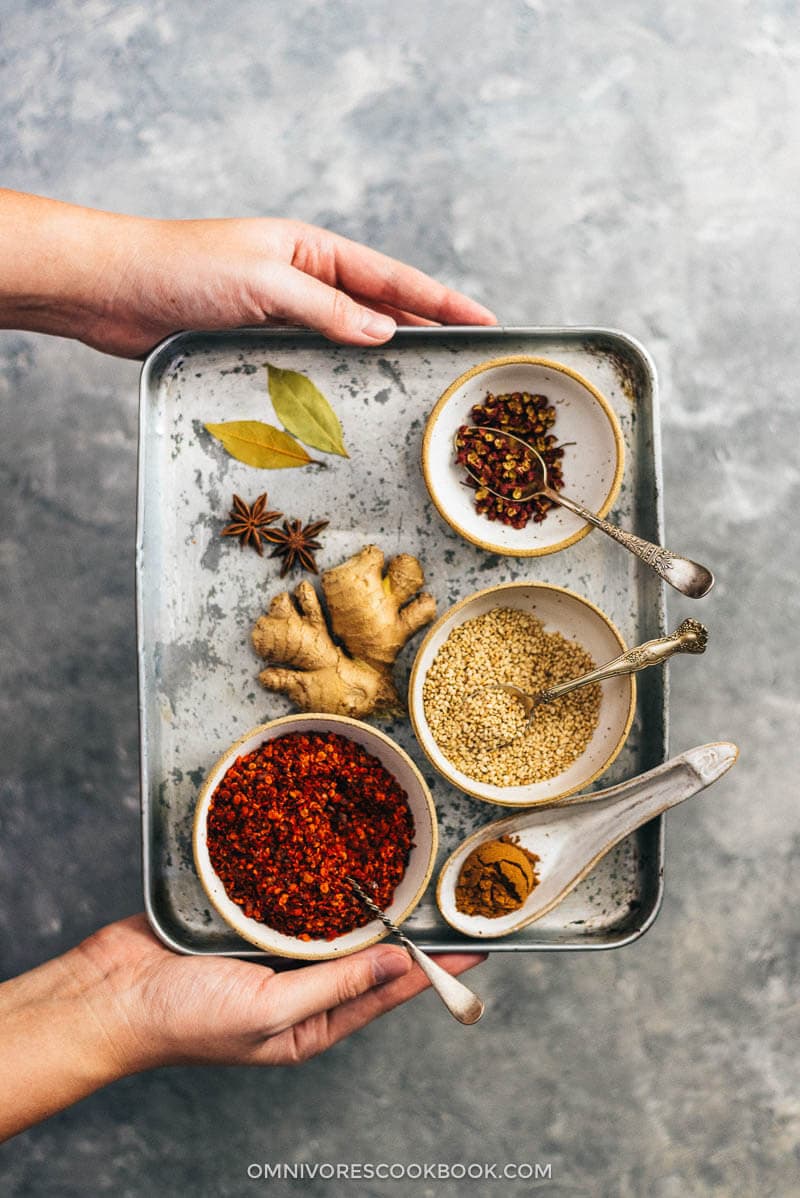
(4) To filter or not to filter the chili flakes?
Once you’ve made the chili oil, you can either filter the oil and discard the chili flakes, or you can leave them in. This habit varies a lot in China depending on the region, so I’d say both methods are authentic and correct.
As a northerner, I grew up having chili oil with tons of chili flakes sitting at the bottom. In fact, in many restaurants you will find the chili oil jar is filled mostly chili flakes and very little oil.
Again, if you choose proper chili flakes (see point #1 above), your chili oil will not be very spicy and it should taste nutty with a balanced umami flavor. The chili flakes should add texture and smokiness to your dish, not spiciness.
How to use chili oil
- Make authentic Sichuan food: Mapo Tofu, Sichuan Spicy Wonton in Red Oil, Sichuan Sliced Beef in Chili Sauce (Fu Qi Fei Pian), Bang Bang Chicken
- Drizzle on soup to make them taste better immediately: Wonton Soup, Instant Pot Chicken Noodle Soup, 15-Minute Curry Ramen with Leftover Ham
- Make a simple cold dish taste irresistible: Real Deal Sesame Noodles, Cucumber Salad
- Use it on congee and oatmeal: 5-Ingredient Savory Oatmeal (Chinese-Style)
- Use it on your roast veggies to add tons of flavor (extremely helpful if you follow a vegetarian or vegan diet)
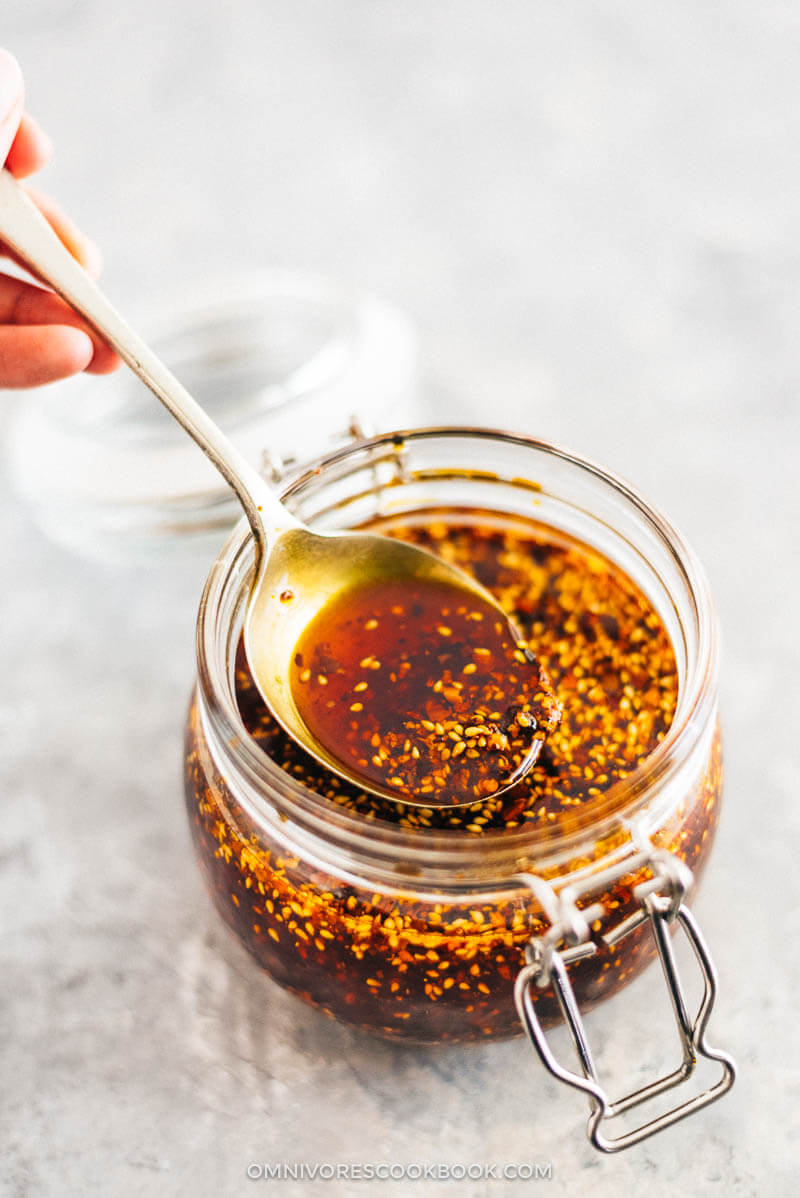
Other homemade Chinese sauces & condiment
- Chinese BBQ Sauce
- Chinese Flavored Sweet Soy Sauce
- Vegetarian Oyster Sauce
- Homemade Black Bean Sauce
If you give this recipe a try, let us know! Leave a comment, rate it (once you’ve tried it), take a picture and tag it @omnivorescookbook on Instagram! I’d love to see what you come up with.
Chinese Cooking Made Easy
Are you new to this website? This free email series is a great place to start. I’ll walk you through a few of my most popular recipes and show you how and why they work. You’ll quickly start to cook better Chinese food in your own kitchen.
Watch video
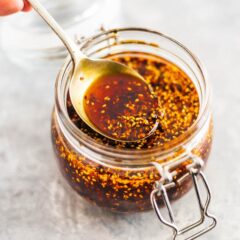
How to Make Chili Oil (辣椒油)
Ingredients
- 4 tablespoons Chinese chili flakes (*footnote 1)
- 2 teaspoons five spice powder
- 3 tablespoons toasted sesame seeds
- 1 teaspoon ground Sichuan peppercorn
- 1 whole star anise (Optional)
- 2 bay leaves
- 1 cup vegetable oil (or grapeseed oil)
- 1 piece thinly sliced ginger (Optional)
Instructions
- Combine chili flakes, five spice powder, sesame seeds, star anise, Sichuan peppercorns, and bay leaves in a heatproof ceramic bowl that can hold at least 2 cups liquid. Place the bowl on a heat resistant coaster.
- Heat oil in a wok (or a skillet) over medium-high heat. Add ginger. When the ginger starts to wither and turns golden brown, immediately turn off the heat. The oil should reach 370 degrees F (190 C) and no higher than 400 F (200 C) if read with an instant thermometer.
- Carefully pour oil or use a ladle to transfer oil into the bowl of mixed spices. The oil will bubble for a few seconds and cook the spices. While the the oil is bubbling, use a metal spoon to stir gently to mix the spices, so they’ll cook thoroughly.
- When the oil cools down a bit, scoop out and discard the star anise and bay leaf.
- The oil is now ready to use! Its flavor will mature if you let it rest for a day, allowing the spices to infuse into the oil.
- The oil can be stored covered at room temperature for two weeks, or up to six months in the fridge in an airtight container.
Notes
Nutrition

Did you make this recipe?
I’d love to hear how it turned out for you! Please take a moment to leave a 5-star rating ⭐️ and share your thoughts in the comments further down the page. It really helps others discover the recipe too.
The recipe was originally published on August 7, 2014, and updated on April 23, 2017.

Lee Chu
I want to thank you for awakening my memories. Some of your recipes remind me of my Father, who is gone now. I can’t wait to try to make these foods; I have not had them in quite some time.
Kinsey Justa
Is it ok to use olive oil for this recipe?
Mary Leung
Hi Maggie – would you ever make the chili oil using an olive oil or avocado oil instead of a vegetable oil ? Or do you recommend sticking with the grapeseed oil ?
Boni sosa
Hi my question can I use corn oil for this recipe or please if I can use oliva oil
Jon
Hi Maggie, thank you for the great recipes, I’m going to make this one today, which do you prefer, peanut or vegetable oil?
Dana Johnson
I have been using the Korean chili flakes for a very plain, but tasty red oil, going way overboard on the flakes to get a strong pepper ( not hot ) flavor which I found wonderful. Seeing the addition of other spices to the oil opens a new door in the world of flavor. I will try it tonight with fresh homade noodles. Been using pepper flakes, black vinegar and oil marinating in a jar to get a good topping comparable to what I got in Xian, Now that I make my own persimmon vinegar, I look forward to a much more flavorsome experience. ( not that the old version wasn’t excellent )
VI
I’ve already done this wonderfully aromatic oil three times, my whole kitchen smells wonderful!!
Emil
Fantastic chili oil recipe; even better in my opinion than Fuchsia Dunlop’s! I love how the rich, earthy spice complements the pepper heat. I used locally-grown santaka pepper flakes.
Maggie T
I made this chili oil, but I want it to be a bit spicier. What can I do to make it spicier? Add more peppercorns? More chili flakes?
Maggie
Hi Maggie, the fastest way to add spiciness is to add some cayenne pepper powder to the blend before pouring in the hot oil. Although you need to experiment with the amount, so your oil won’t end up too spicy. If you want to make the existing jar of oil spicier, I would heat up a few tablespoons oil and cook cayenne pepper powder in it. Then blend the super spicy oil into your current jar to bring up the spiciness.
Maggie T
Thank you! I will try that!
steve
Great recipe, but use extra virgin peanut oil if you can find it. It takes it to the next level!
Barbara
Hi Maggie, can this oil also be stored in the counter? Thanks in advance!
Maggie
Hi Barbara, yes, you can store the oil at room temperature on your counter. Just to make sure to avoid direct sunlight and use an airtight jar. It stays good for couple weeks.
Janet Einhorn
Hi Maggie – I have been enjoying your website very much. I hope to make this recipe in combination with your Dan Dan Noodle recipe. I don’t know whether my ceramic or glassware is truly heat-proof. Could I use a small cooking pot instead?
Thanks,
Janet
Maggie
Hi Janet, a small cooking pot is perfect for making the oil! I often use it myself because I cook the chili oil in big batches.
Happy cooking and hope your chili oil turns out great!
Mark Zambelli
I really like the idea of using five-spice powder so I tried your recipe last weekend and it was lovely. I hope you don’t mind too much but I tweaked it a little (sort of hybrid of my usual go-to version) by adding sesame-seed oil after it has cooled for a couple of hours, and byincreasing the Szechuan pepper. I also add a couple of cloves of very finely chopped garlic to the dry chili flaķe mix and it worked well. Thankyou for sharing.
Maggie
Hi Mark, I’m glad to hear you like the recipe! No worries about tweaking the recipe and I’m happy that you can find cool ways to make the chili oil tastes even better! I love the idea of adding garlic and sesame oil too and sometimes I do that at home 🙂
Thanks for taking time to share your method and hope you have a great day!
Sarah
I’ve made this twice now, and it’s just fantastic! I especially like how you gave the “ginger” method for testing the oil heat. I used it and it worked great. I was originally hesitant about using star anise (because my husband doesn’t like the flavor) but it doesn’t flavor it strongly, more like lending a sweet/smoky richness to it. I’ve even used this oil as an accompaniment to spoon on top of some cheese on a cheese platter 🙂
Maggie
Hi Sarah, so glad to hear the recipe worked for you and thanks for taking time to leave a comment!
Use chili oil on a cheese platter? That’s a brilliant idea! I’ll try it out the next time. Yum!
Thanks for sharing and have a great day 🙂
Tay
Made it the aroma was just incredible! Going to try it over CNY?
Sue
Hi Cheff, How long the hot chilli oil will expired ?
Maggie
Hi Sue, the chili oil lasts very long in if you store it in an airtight jar in the fridge. Pretty sure some of my old chili oil dates back to 6 months ago (or even longer). They taste the best while fresh, but they last very long and you can use it as long as the oil still smell good.
Ermyas
Hello Maggie, I just made it! Yummy even without the Star anise. Thank you for sharing your recipe.
Greg
Hey Maggie, great recipe! Just tried it out, and I have one quick question. I was unsure about the temperature of my oil. If some of the chili flakes are floating and some rest at the bottom of the container (maybe 50/50 ratio), do you think that means the floating flakes were undercooked? Or is this normal for chili flakes from Mala Market? Thanks!
Maggie
Hi Greg, sorry for the late reply. To answer your question, once you pour in the oil, some of the chili flakes will be floating on top but most of the chili flakes should sink to the bottom once the oil is cooled down. If half of the flakes are floating, the oil temperature is probably not high enough.
Victoria Brenha
Best Chilli Oil recipe to date! I substituted a little sesame oil because I didn’t have sesame seeds on hand and also added a pinch of salt. The other chilli oils I made in the past were boring compare to this. Yours has that layered, deep rich flavour. I’m going to check out the rest of your recipes. Cheers, Vic
RainDrop
Oh my, I don’t know how could I have lived without it! I simply LOVE this recipe-the taste is so perfectly balanced and totally addictive. Thank you for sharing!
Maggie
You’re the most welcome! Me too, I have have a big jar in my fridge because it’s such a staple 🙂